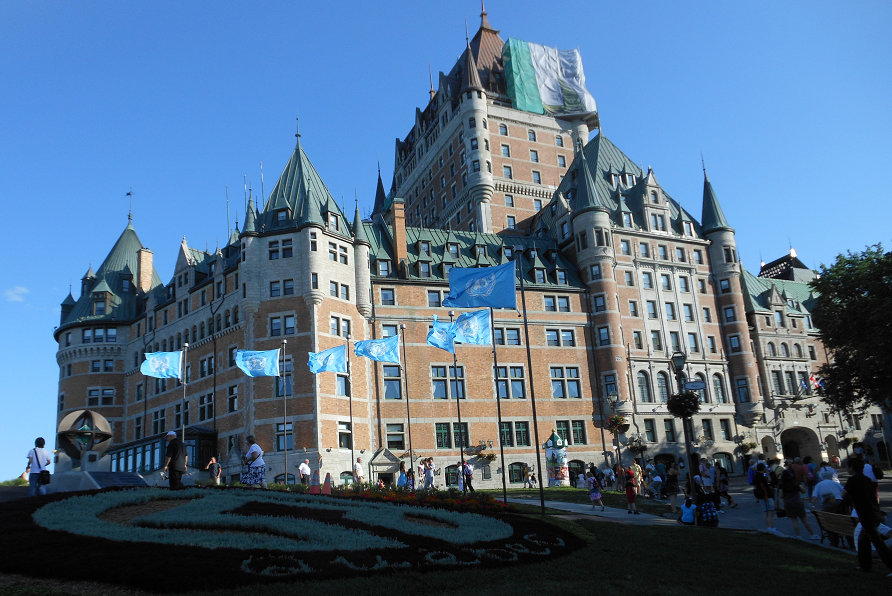The remainder of our week in the province of Quebec begins with a whirlwind 24-hour visit to the provincial capital. Arriving midafternoon, we checked in at the residences of Laval University, with its affordable lodging and a place to park the car. Catching a bus heading into downtown, we debarked at the entrance to rue St Jean, gateway to the section of the old city that sits high on the hill. In 1608, the French explorer Samuel de Champlain chose the site as his base because of its excellent vantage point high on the ramparts overlooking the St Lawrence River.
Like many of the old cities of Europe, the original city of Quebec was built within a fortress, and its walls still remain. The gateway at rue St Jean now opens onto the main thoroughfare for pedestrian traffic in the old city, and as we walk through we join the throngs of tourists visiting the shops, restaurants and bars that line the street.
We’ve arrived in Quebec during the Festival d’Ete de Quebec, host to street performers and live music on stages located within the walls as well as outside them on and near the Grande Allee, with its many bistros and late-night clubs.
The charm of Vieux Quebec lies in its architecture, and among its many old buildings is the majestic Chateau Frontenac, built in the late 1800s, one of the chateau-style hotels built along the Canadian Pacific Railway. The railroad was built at the instigation of the Canadian government with the intention of linking the west coast with the east, uniting the country and waylaying fears that the people and lands of the west would get sucked into the U.S. So the railroad was built, and to encourage travel from east to west, hotels were built to serve wealthy patrons in cities along its tracks, and it worked. Chateau Frontenac, with its views up and down the river, is but one fine example.
There is much to admire at every turn.
Below the ramparts, the lower section of the old city can be reached from above by funicular. The lower section is home to boutiques and restaurants as well as small businesses that line its narrow cobblestone streets that fan out toward the piers on the river. We head that way late morning of our second day in town, taking the car and parking it in a lot near the river, strolling over to the farmers market on the riverfront.
Enjoying our basket of fresh raspberries, we wander inland from the piers toward the bottom of the hill. We pass artisans with their many wares, folks stopped in for lunch at one of the many outdoor restaurants, and shops that cater to visitors with their pocketbooks.
Our wanderings lead us to to Parc de la Cetiere – an open cobblestoned area that is set beneath the rampart and nestled beside a tall building wall with a mural that depicts both the old and the new of the city.
A small stage is set up and before long, we are treated to a half-hour set by a local musical duo whose name I only wish I remembered. An absolute delight and we enjoy their show immensely, complete with fiddle and a variety of instruments that make up their traditional sound.
Beyond the parc, the street opens up into a plaza that at one end houses one of the oldest stone churches in North America – Notre Dame des Victoires – a Roman Catholic church built in the late 1600s.
View of the plaza from the church steps

Quintessential view in Vieux Quebec

A self-professed live music junkie, Shannon is the author of Astral Weeks Live: A Fan’s Notes, a book about her year on the road attending singer Van Morrison’s epic live performances of his widely acclaimed album Astral Weeks. To find out more about the book or to order a copy signed by the author, click here.













Leave a Reply